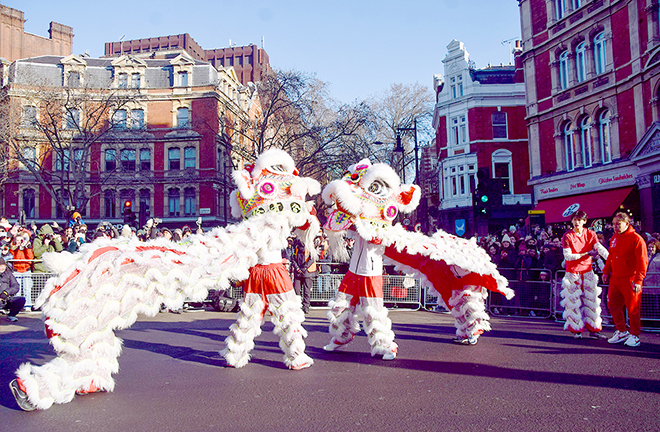Traditional Chinese festivals going global

Traditional lion dancers stage a performance to celebrate the Chinese New Year in London’s West End on Jan. 22. Photo: CFP
Many countries around the world are enthusiastically celebrating the Chinese Lunar New Year, as Chinese festivals are attracting worldwide attention for their unique charm.
The report to the 20th CPC National Congress called for extending the reach and appeal of Chinese civilization, stressing that “we will collect and refine the defining symbols and best elements of Chinese culture and showcase them to the world” and proposing better presenting Chinese culture to the world. Traditional festivals are a key component of fine traditional Chinese culture and an important embodiment of national and cultural identity.
Overseas dissemination
Nowadays, cases of Chinese festivals successfully going global are increasing. The Chinese New Year has become an internationally influential festival, and has been designated as a public festival by a growing number of countries. In the night of the Minor New Year, which fell on Jan. 13 this year, the British landmark the London Eye was lit up in red, a festive color for the Chinese New Year, and against the backdrop, traditional lion dances were performed. At the Chinese New Year Flower Market Fair in San Francisco, customers and vendors greeted each other with “Kung Hei Fat Choy,” which means “wish you prosperity and good fortune.” Cordial Chinese New Year greetings from different races have contributed to the world’s diversity.
Uniqueness of Chinese festivals
Why are traditional Chinese festivals so popular? Zhong Xin, a professor from the School of Journalism and Communication at Renmin University of China, and her research team found that although the origins of traditional festivals vary with countries, many major traditional festivals are celebrated with family reunion, characterized by an atmosphere of happiness and joy, as well as good food. Traditional Chinese festivals have also become a medium for interaction and resonance among different groups of people, and an indispensable vehicle for the spread of Chinese civilization.
“The themes of Chinese festivals, such as the time and seasons, joyful gatherings, health and blessings, and remembrance of ancestors, contain traditional Chinese values such as the unity of nature and humanity, harmony, the way of yin and yang, and family relations and kinship,” said Fan Hong, director of the National Image Research Center at Tsinghua University.
Citing the Chinese New Year as an example, Fan told CSST that as a classic symbol of Chinese culture in international communication, the festival has effectively promoted cross-cultural exchanges between China and foreign countries.
The Chinese New Year has been officially approved as a local festival by governments of many countries and cities. More and more people in different countries celebrate the Chinese New Year with overseas Chinese, which has turned the festival into a crucial bridge to connect them and to enhance the cultural identity of overseas Chinese, Fan said.
Chinese festivals also provide a channel for people in other countries to understand fine traditional Chinese culture. Wu Fei, a professor from Zhejiang University, noted that different cultural traditions reflect varying understandings of the relationship between heaven, earth, humanity, and deities. Festivals enable people to deepen their knowledge of other cultures and create interactive values.
New communication features
In the past 10 years of the new era, the overseas communication of Chinese festivals has exhibited new characteristics. They are increasingly in touch with the youth and daily life. Communication methods have become more creative, facilitated by digital intelligence and media integration. Through creative cultural channels such as games, literature, animation, film and television, drama, and integrated media, cultural resources of Chinese festivals have engaged growing numbers of overseas young people with an interest in Chinese culture.
For example, the Chinese Festivals serial program created by Henan Television covered a wide range of traditional Chinese festivals, from the Chinese New Year, Lantern Festival, Qingming Festival, Dragon Boat Festival, to the Qixi Festival, Mid-Autumn Festival, and Chongyang Festival. Digital means have brought festival culture to life, and festival stories are told in a way close to reality, taking audiences back to ancient settings and offering a feast of traditional Chinese culture to the global audience. As such, they have gone viral around the world.
At the same time, the spread of Chinese festivals on overseas social media platforms has increased their popularity, allowing more people to understand Chinese festival culture and get involved on social media.
Scholars believe it is necessary to disseminate Chinese philosophy and cultural views at a deeper level through Chinese festivals, so as to enhance the resonance with Chinese culture and share the cultural feast of Chinese festivals with people from across the world.
Edited by CHEN MIRONG
